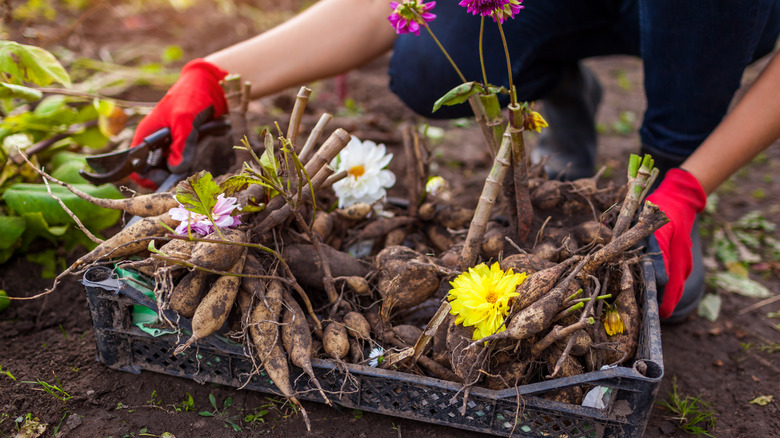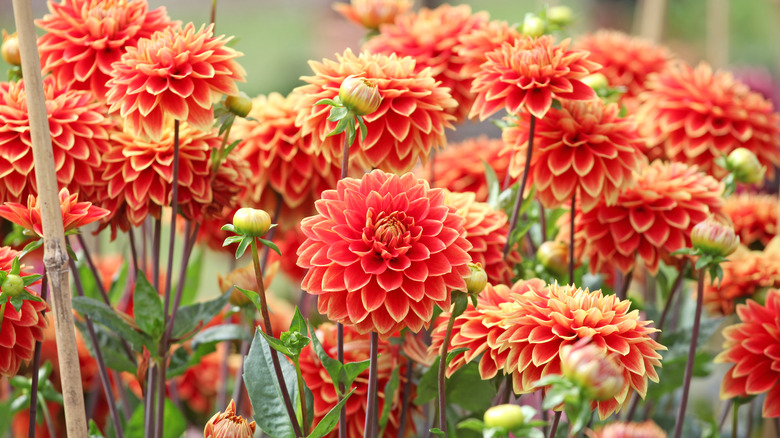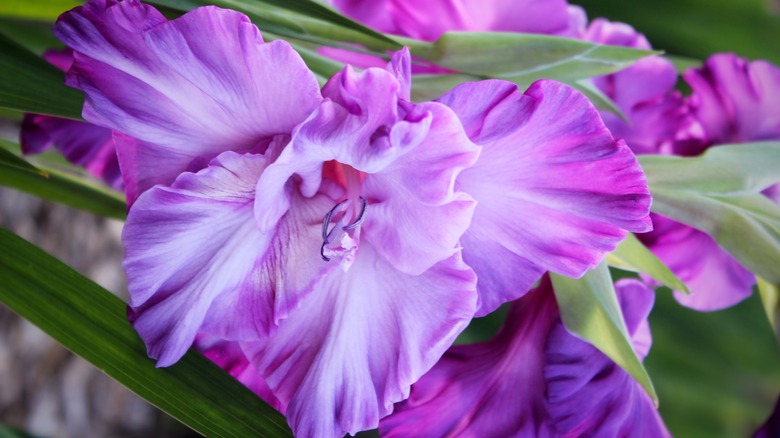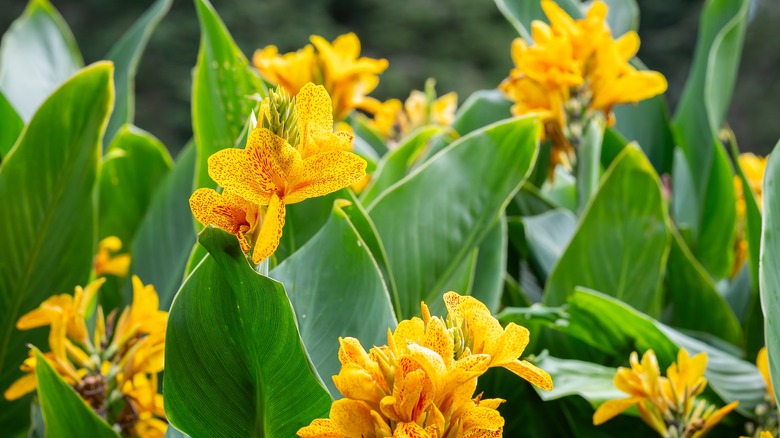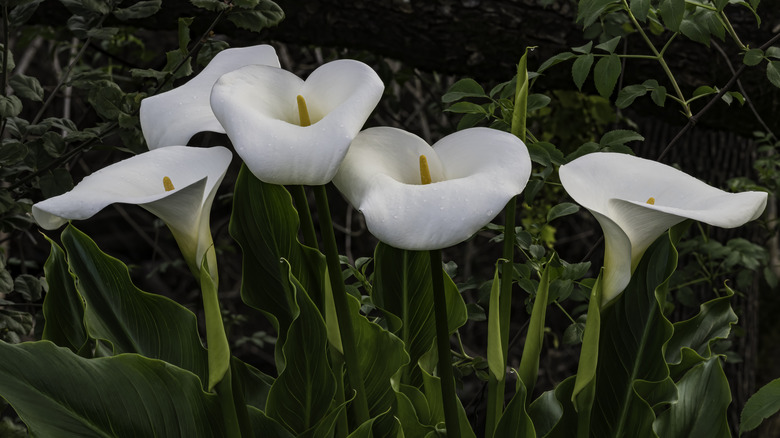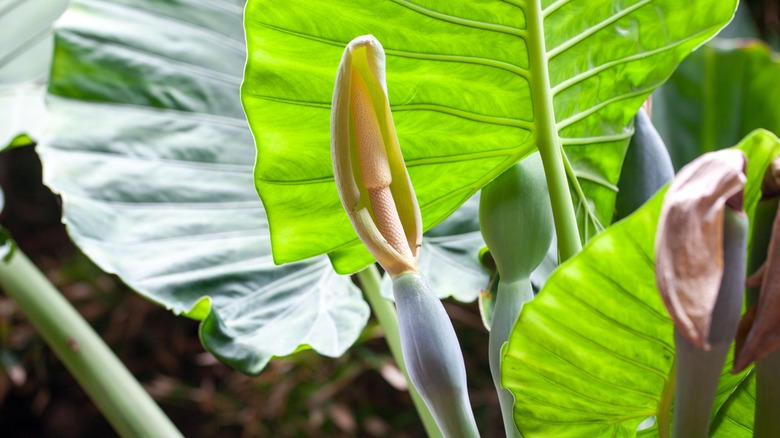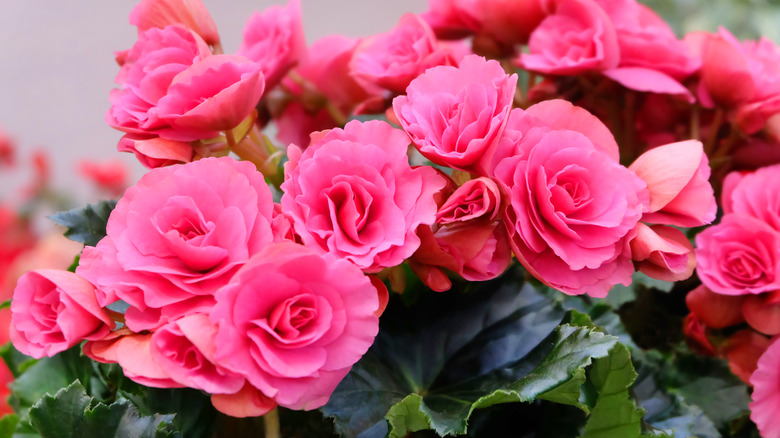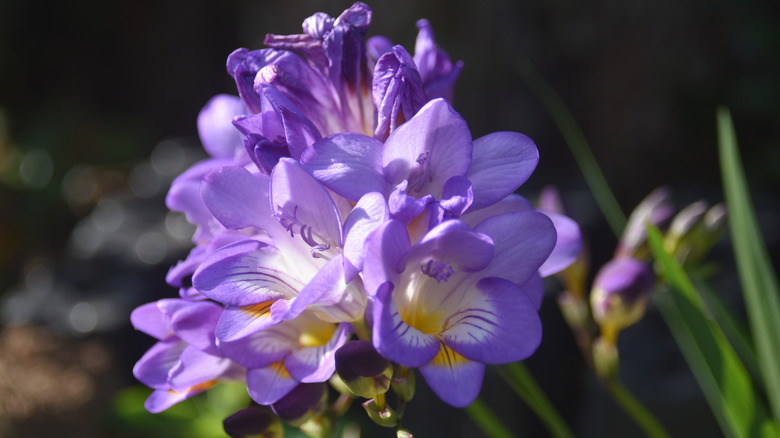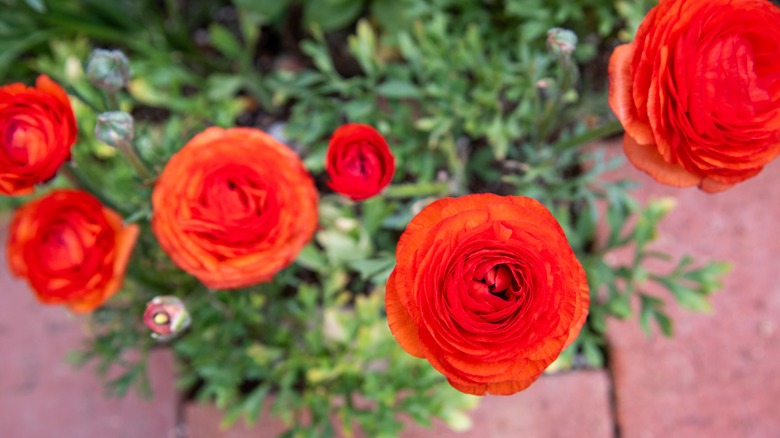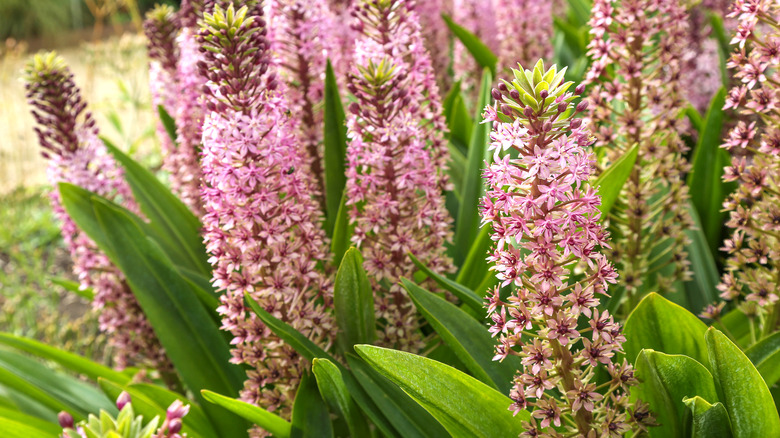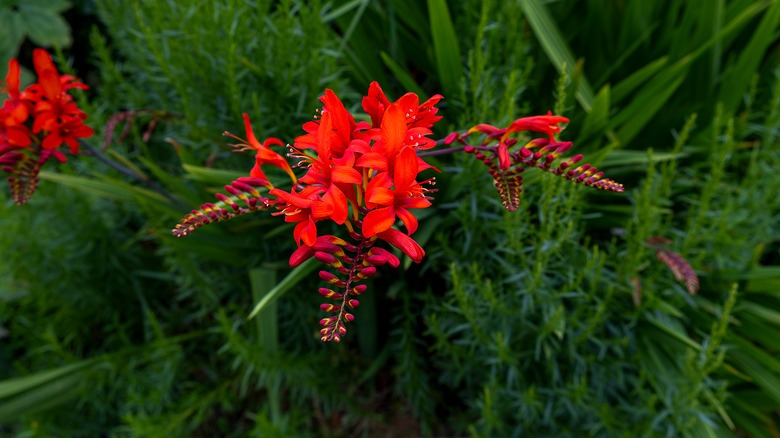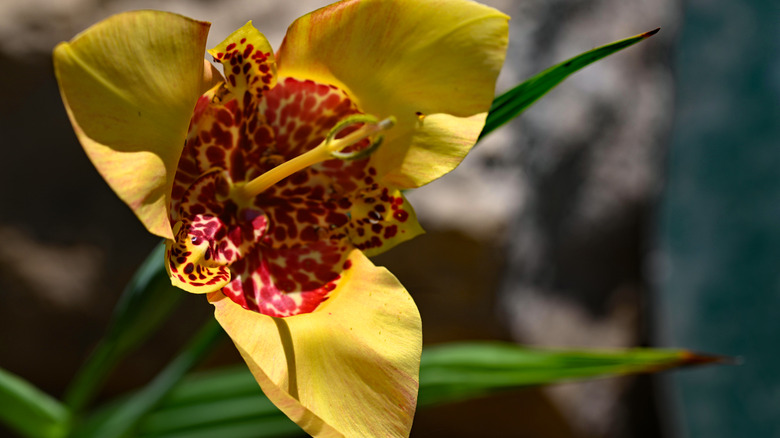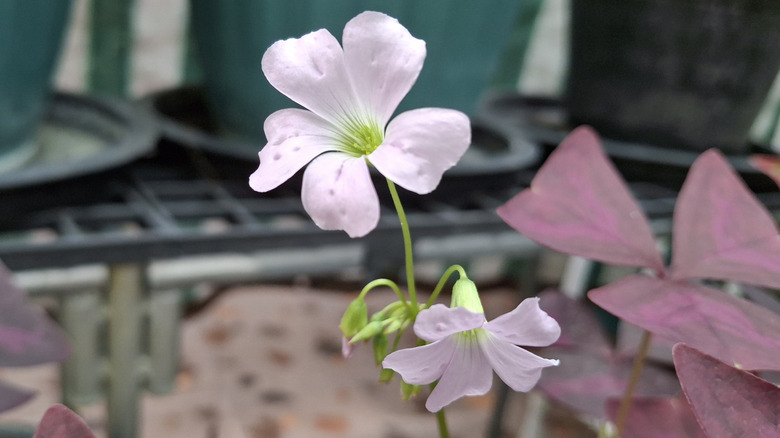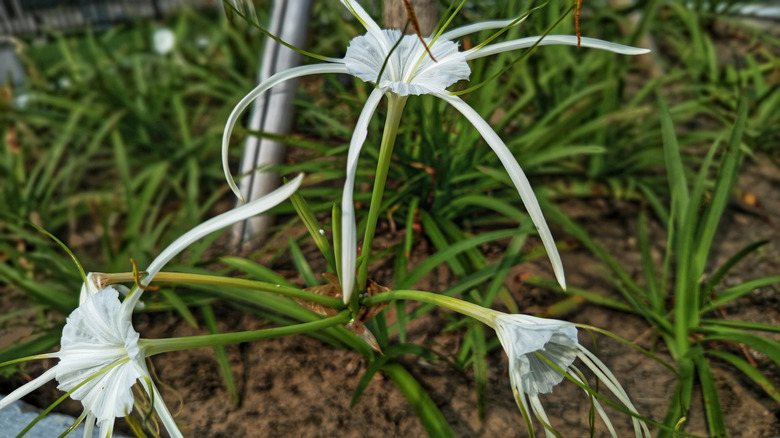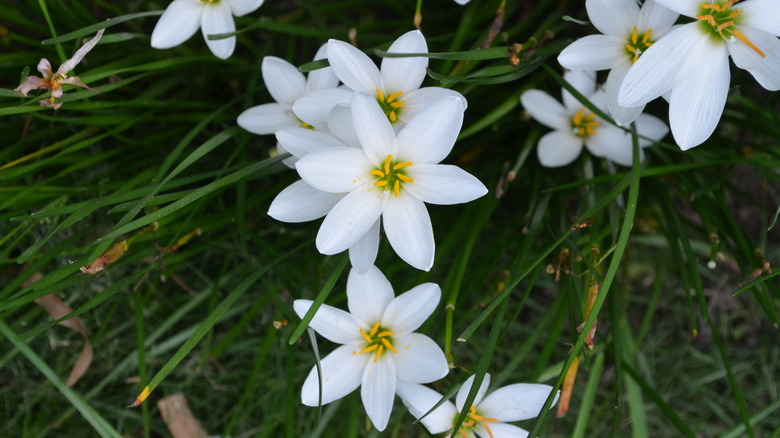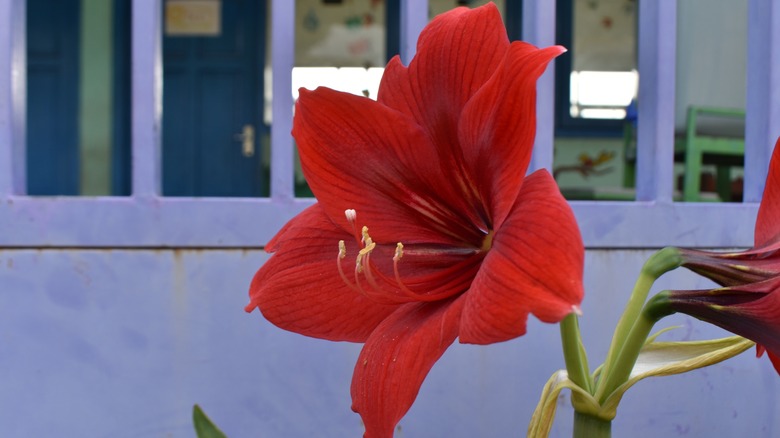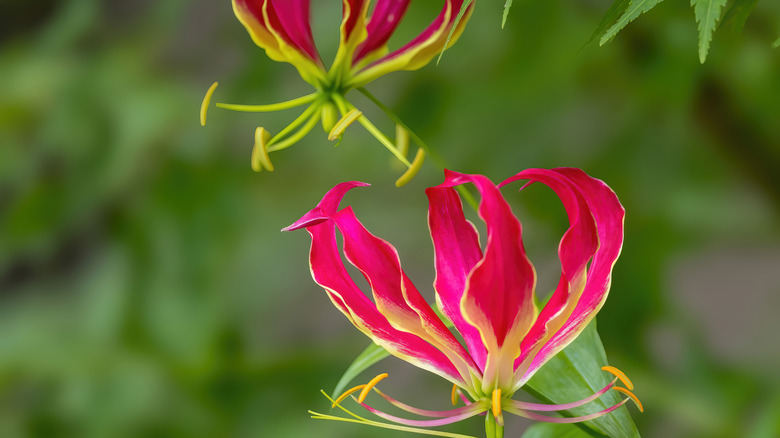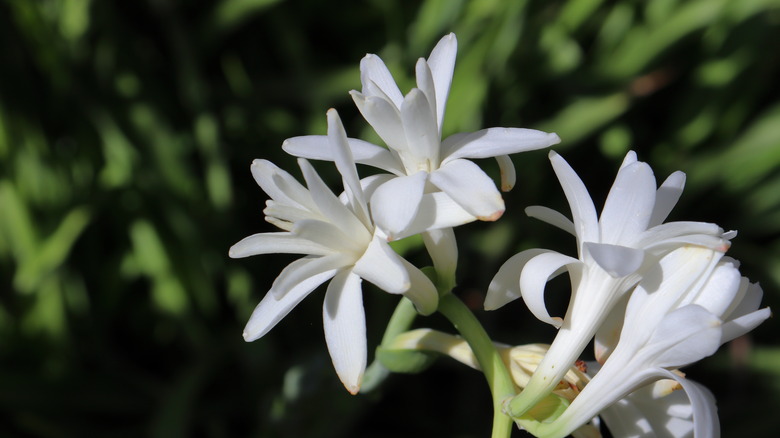17 Cold-Sensitive Flowers To Dig Up And Save For Next Season
Fall gardening tasks are well underway, and it's time to start thinking about the best method to overwinter all of your favorite plants. The protocol for helping your plants survive the winter varies from species to species. Some are hardy enough to tough it out all winter in the ground under a layer of mulch. However, you may want to consider digging up tender bulbs, tubers, and corms to save them for next season. Popular flowering plants requiring this treatment include dahlias, calla lilies, elephant ears, freesias, and amaryllis, among many others.
Lifting and storing bulbs, corms, or tubers is a great way to save money and enjoy your favorite flowers year after year. You'll know it's time to dig up your bulbs when the foliage withers and dies back. Before you go digging up your bulbs, be sure to have some important materials handy. Many bulbs contain toxins that could irritate your skin. Wear your gardening gloves throughout this process. You'll also need a trowel and shears. To lift your flowers, carefully dig up your bulbs and trim off any excess foliage. Allow them to cure in a container filled with something like peat or paper for a couple of days. After they dry out, you can store them in a cool, dry place until it's time to plant them again.
Dahlias
Overwintering your dahlias (Dahlia spp.) indoors is vital for gardeners in colder regions. While this plant is considered a perennial in USDA Hardiness Zones 8 to 11, it is susceptible to frost damage in Zones 7 and below. To save your tubers for the next growing season, dig them up after your first frost, once the dahlias' foliage dies back. From there, clean off the tuber, and allow it to dry before storing it away in vermiculite, peat moss, or sand until spring.
Gladiolus
Gladiolus (Gladiolus spp.) are beloved for their sword-like foliage and bold blooms. While they grow in colder regions, you'll need to dig up their corms in the fall. If you live in USDA Hardiness Zone 7 or below, you'll know it's time to lift your gladiolus flowers right before or after the first light frost kills the foliage. The flowers of plants grown in Zone 7 may survive the winter without lifting, but those in Zone 6 and below should be dug up. If you want to attempt overwintering in the ground, mulch your plants with hay or straw.
Canna lilies
Prized for their tropical blooms and stunning foliage, canna lilies (Canna x generalis) are considered perennials in USDA Hardiness Zones 7 to 11. However, their rhizomes won't survive outside in colder regions. To preserve the plant for next spring, dig about a foot away from the stem, being careful not to damage the bulbs. Clean off the rhizomes and clip any foliage. Divide the plants into clumps of three to five, and cure them for a few days. Once they're dry, wrap them in paper, and store them in a dry growing medium with plenty of room between them.
Calla lilies
Calla lilies (Zantedeschia spp.) are considered perennials in USDA Hardiness Zones 7 to 10. In colder regions, you need to dig up their rhizomes if you want to grow them again in the spring. Start by trimming the leaves and stem about two inches above the ground. Next, carefully lift the rhizomes out and dust off any soil. Cure them in a 60- to 70-degree Fahrenheit space for three days. Once they're dry, place them in a container filled with slightly moist sawdust or pine shavings and store them somewhere cool and dark until spring.
Elephant ears
Elephant ears are a large group of tropical plants that includes the genera Colocasia, Alocasia, and Xanthosoma. These plants feature large arrow- or heart-shaped leaves that generally grow from corms. They can grow up to 3 feet long and 2 feet wide. Most gardeners prize the plants for their showy foliage, but there are varieties that bloom. While most elephant ears are hardy to Zone 8, they need to be lifted in colder regions.
Tuberous begonias
Beloved for their vibrant blooms, tuberous begonias (Begonia spp.) are often seen cascading out of garden beds. They boast an extended blooming season, flowering generously from summer to fall. To enjoy these flowers season after season, you'll need to prepare them for dormancy and lift their tubers. Slowly reduce watering and fertilization as you near the end of the growing season. Once the plant begins to yellow, dig up the tubers and trim the stem to about 5 inches before storing them.
Freesia
Freesias (Freesia spp.) are a beautiful cut flower bulb you plant in March for summer blooms. They're considered perennials in USDA Hardiness Zones 9 to 10. In any other region, you'll need to lift their corms. Once your freesias stop blooming, cut off the stems and wait for the foliage to die back. Cut back any yellow foliage before your first frost. Now, carefully dig up the freesia corms and leave them to dry out. Once they are completely dry, dust off any dirt, and store them in peat moss or vermiculite. Keep them in a cool, dark place until spring.
Buttercup
These rose-like blooms are considered perennials in USDA Hardiness Zones 8 to 10. In any other region, you'll need to lift buttercup (Ranunculus spp.) in order to enjoy the flowers again in the spring and summer. Wait for the blooms to fade and foliage to die back before digging out the tubers and cutting off any remaining leaves. Keep in mind that you'll need to wake up your buttercup tubers next season by soaking them in room temperature water for three to four hours before planting.
Pineapple lily
The pineapple lily (Eucomis spp.) is a funky, tropical flower that is considered a perennial in USDA Hardiness Zones 7 to 10. In any region below Zone 7, it's important to overwinter this plant indoors. Trim back foliage once it yellows. Next, carefully lift your pineapple lily bulbs and allow them to dry out completely. Store them in a cool, dry, dark place until the threat of frost has passed the following spring.
Coppertips
Known for their unique, iris-like blooms, coopertips (Crocosmis spp.) are another flowering plant you should lift in the fall. They're perennial in USDA Hardiness Zones 6 to 9. Even though they're slightly hardier than other summer-blooming plants, if you live anywhere below Zone 6, you should still dig the plants up to store until spring. Once the blooms are spent, cut the flower stem down but leave the foliage on the plant to provide the corms with nutrients. Once the foliage dies back on its own, you're free to dig them up.
Tiger flower
Tiger flowers (Tigridia pavonia) are another cold-sensitive flowering bulb that should be dug up to save for spring. It's a favorite of many gardeners because of its showy, unique blooms. This bulbous perennial is capable of staying in the ground through the winter in USDA Hardiness Zones 8 to 10. However, it needs to be lifted and stored in cooler regions. Once the plant's foliage dies back, carefully dig up its bulbs and store them safely.
Shamrocks
Most tender shamrocks (Oxalis spp.) are considered perennials in USDA Hardiness Zones 7 to 10. While you may associate shamrocks with the classic four-leaf clover, they're not related. Instead, the Oxalis genus boasts a number of unique species, most of which bloom generously from spring to fall. If you live outside of this plant's hardiness zone, dig up the bulbs or tubers (depending on the species) before the first frost. Carefully extract them from the soil, dust off the dirt, and store them in a cool but not frosty place until spring.
Spider lily
Gardeners love spider lilies (Hymenocallis spp.) for their funky fragrant flowers. Their blooms look like a firework, with long tendrils exploding from a heavily petaled center. Each spider lily species has its quirks. For example, the tropical Caribbean spider lily (Hymenocallis caribaea) is perennial in USDA Hardiness Zones 7 to 11, while the native hammock spider lily (Hymenocallis occidentalis) thrives in the colder climes of Zones 5 to 8. In this case, you really need to know which species of spider lily you have in the ground to decide whether to dig up the bulbs for overwintering.
Rain lily
There are over 70 species of rain lilies (Zephyranthes spp.) featuring various flower colors, including white, pink, and yellow. Plants in the genus grow natively from southern North America all the way down to South America. This crocus-like blooming bulb is prized by gardeners because it is evergreen in mild climates. However, most rain lily species and cultivars should still be lifted and stored for the winter if you grow anywhere below Zone 7.
Amaryllis
While amaryllis (Hippeastrum spp.) are typically kept as indoor plants even novices can impress with, they are actually suitable to grow outside, too. While they can survive the winter in USDA Hardiness Zones 7 to 10, they must be pulled from the soil in colder regions. Prepare your amaryllis for overwintering by encouraging the plant into dormancy. After it's done blooming in the summer, allow it to grow actively for about 8 to 10 weeks. Reduce watering slowly until the leaves yellow and die off. After that, you can lift your bulbs and store them in pots until next spring.
Gloriosa lily
Gloriosa lilies (Gloriosa superba) are hardy above Zone 9. Gardeners in colder regions should lift their gloriosa tubers if they want to save them from the winter cold. As your gloriosa lily's blooms begin to fade, slow down your watering schedule. The plant will often put its energy into producing a second tuber that you can also dig up for storage. Gloriosa lily tubers are particularly vulnerable to dehydration, so store them in a shallow pot filled with vermiculite, peat moss, or sand and check on them throughout the winter.
Tuberose
Tuberose (Polianthes tuberosa) is another cold-sensitive flower you should consider digging up in the fall if you want to grow it again in spring. This fragrant bloom is perennial in USDA Hardiness Zones 7 to 11. It features white, waxy flowers with a fragrance that is particularly attractive to moths. In colder regions, you'll want to dig up the bulbs after the first frost. Blackened foliage signals that it's ready to lift.
